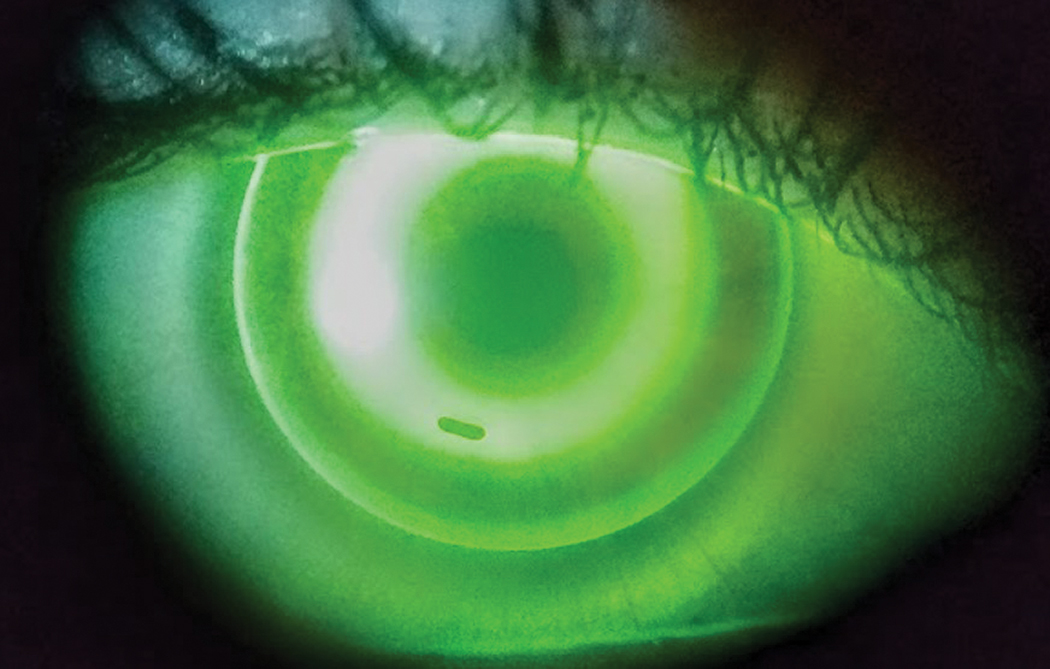 |
| Special care should be taken when recommending ortho-K in patients with higher levels of myopia and corneas with less prolate shape, providing more realistic expectations and even changing to dual axis or more sophisticated designs. Photo: Dan Fuller, OD. Click image to enlarge. |
While orthokeratology (ortho-K) lenses tend to be an efficient option for myopia control, discontinuation of this treatment is not uncommon. In a new study, researchers aimed to evaluate the efficacy, safety and participant compliance of ortho-L treatment for the correction of myopic refractive errors over six months and to define the potential reasons for early treatment discontinuation. They found that ortho-K is efficacious and safe for the correction of low-to-moderate myopia in adults, but a portion of patients discontinue the treatment in the first six months of contact lens wear.
A total of 32 participants with low-to-moderate myopia were fitted with ortho-K lenses and followed over six months, with specific attention to alterations in refractive error, corneal topography and epithelial thickness. Participant feedback and reasons for any treatment discontinuation were documented.
Significant changes in refractive error and corneal topography were observed, with approximately 50% of the refractive error being corrected on the first night of use and 100% by the first two weeks. Central epithelial thickness experienced substantial thinning, reducing to 15.65 ±4.49µm (67.4% of pretreatment level) after six months of lens use, which is consistent with previous studies. In addition, changes were observed from the first hour of wearing the lenses, coinciding with what was reported by other authors.
The mid-peripheral corneal epithelium showed a thickening after a month of use, with a statistically significant change achieved in the third month of use, which aligns with previous findings.
“This could suggest that while the corneal epithelial thickness experiences the most substantial changes from the initial stages of ortho-K treatment, the mid-peripheral area also undergoes notable changes, but as the treatment advances,” the researchers explained in their article for Eye & Contact Lens. “These assertions were also stated in a systematic review that was recently published.” The paracentral zone also experienced a thinning on lens use, albeit to a lesser degree than at the central level (7.02 ±5.15µm).”
Six participants withdrew from this study for various reasons, including unmet visual expectations and difficulty adhering to the lens-wearing regimen. The authors noted that the dropout group exhibited higher baseline low-order aberrations and less prolate corneas than those who persisted with the treatment.
“It is crucial to consider that while ortho-K adjusts refractive error and enables visual acuities equivalent to, or sometimes exceeding those achieved with ophthalmic correction, it also induces high-order aberrations, leading to a decrease in contrast sensitivity,” the authors explained. “This can jeopardize patients’ visual quality, being intolerable for some of them.”
Spherical aberration and higher-order aberrations (HOAs) values tended to shift toward more positive values from the onset of lens usage, which aligns with previous studies. “Moreover, these participants with a baseline refraction between -3.00D and -4.50D showed a more pronounced increase in HOAs values, as in a previous series,” the authors explained. “Consequently, HOAs induced with the ortho-K can play a crucial role for discontinuing the refractive corrective procedure.”
Another contributing factor might be the presence of residual astigmatism not fully mitigated by the ortho-K lenses. There were patients meeting the study’s inclusion criteria and reaching UDVA of 0.00 logMAR with ortho-K, in which the treatment did not allow a full correction of astigmatism and visual quality was not fully satisfactory, the authors noted.
Two individuals stopped the use of ortho-K lenses because of the inability to adhere to the nightly lens-wearing routine, attributed to forgetfulness or negligence. The discomfort experienced while using the lenses led another participant to stop the treatment, which was the principal reason for contact lens users to discontinue their use.
“In conclusion, ortho-K with corneal refractive therapy lenses has demonstrated efficacy and safety as a correction method for patients with low-to-moderate myopia and with a high treatment success rate. Nonetheless, it is imperative to adequately inform patients regarding the critical nature of adhering to the treatment and the impact of these lenses on visual quality,” the authors concluded. “Establishing realistic visual expectations is also vital to circumvent potential treatment discontinuations. Prefitting values of corneal asphericity, uncorrected visual acuities and low-order aberrations are crucial parameters that should be considered when planning ortho-K for myopia.”
Sanchez-Garcia A, Molina-Martin A, Ariza-Gracia MA, Pinero DP. Analysis of treatment discontinuation in orthokeratology: studying efficacy, safety and patient adherence over six months. Eye & Contact Lens. [Epub ahead of print.] |


